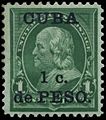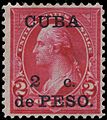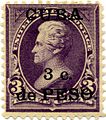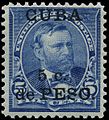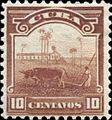
An overprint is an additional layer of text or graphics added to the face of a postage or revenue stamp, postal stationery, banknote or ticket after it has been printed. Post offices most often use overprints for internal administrative purposes such as accounting but they are also employed in public mail. Well-recognized varieties include commemorative overprints which are produced for their public appeal and command significant interest in the field of philately.

A piece of postal stationery is a stationery item, such as a stamped envelope, letter sheet, postal card, lettercard, aerogram or wrapper, with an imprinted stamp or inscription indicating that a specific rate of postage or related service has been prepaid. It does not, however, include any postcard without a pre-printed stamp, and it is different from freepost for preprinted cards issued by businesses. In general, postal stationery is handled similarly to postage stamps; sold from post offices either at the face value of the printed postage or, more likely, with a surcharge to cover the additional cost of the stationery. It can take the form of an official mail issue produced only for the use of government departments.
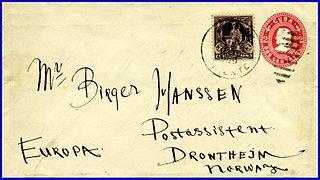
A stamped envelope or postal stationery envelope (PSE) is an envelope with a printed or embossed indicium indicating the prepayment of postage. It is a form of postal stationery.
This is a list of philatelic topics.
This is a survey of the postage stamps and postal history of British East Africa.

The British Central Africa Protectorate existed in the area of present-day Malawi between 1891 and 1907.

The French post offices in Egypt were a system of post offices maintained by France in Egypt during the 19th century and the early years of the 20th century. They were primarily intended to facilitate commercial and trading interests that needed to communicate between France and points east.
This is a survey of the postage stamps and postal history of Macau.

Postage stamps and postal history of the Canal Zone is a subject that covers the postal system, postage stamps used and mail sent to and from the Panama Canal Zone from 1904 up until October 1978, after the United States relinquished its authority of the Zone in compliance with the treaty it reached with Panama.
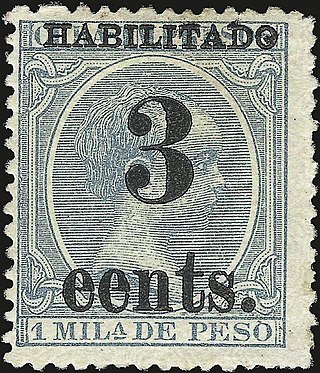
Linn's World Stamp Almanac defines a provisional stamp as "a postage stamp issued for temporary use to meet postal demands until new or regular stocks of stamps can be obtained."

The postal history of Malta began in the early modern period, when pre-adhesive mail was delivered to foreign destinations by privately owned ships for a fee. The earliest known letter from Malta, sent during the rule of the Order of St John, is dated 1532. The first formal postal service on the islands was established by the Order in 1708, with the post office being located at the Casa del Commun Tesoro in Valletta. The first postal markings on mail appeared later on in the 18th century.

The postage stamps and postal history of Guam is an overview of the postage stamps and postal history of the United States territory of Guam. Its postal service is linked to those of the Philippines during the Spanish Empire and, since 1898, to the United States of America. A peculiarity is that, for a short period in the 1930s, Guam had a local post service.

Postage stamps of Pakistan are those issued since Pakistan's independence in 1947. Pakistan Post has issued more than 600 sets and singles totalling more than 1300 stamps. Immediately after the independence of Pakistan in 1947, the new Pakistan government was preoccupied with setting up the government so British Indian stamps continued in use without an overprint as was the practice in other countries.

Germania stamps are definitive stamps that were issued by the German Empire and the Weimar Republic between 1900 and 1922, depicting Germania. They represent the longest running series in German philately and are in their many variations and derivations an essential part of German philatelic collections.

This is a survey of the postage stamps and postal history of Gibraltar.
Belize started as the colony of British Honduras, formally established in the 17th century but disputed through the 18th century.
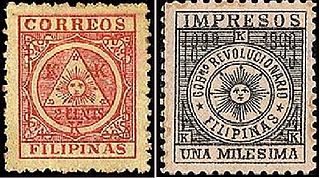
This is a survey of the postage stamps and postal history of the Philippines.

This is a survey of the postage stamps and postal history of the Nyassa Company.
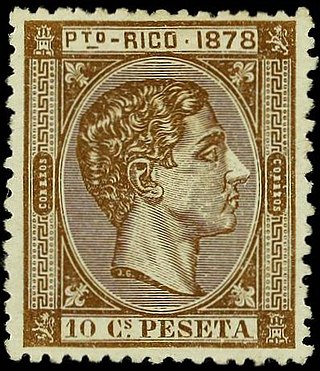
The postal history of Puerto Rico began around 1518, at least for official mail, when Spain adopted general postal regulations; although the first documentation of Spanish postal regulations specific to the Caribbean was 1794. The first postage stamps were issued 168 years ago for Puerto Rico and Cuba in 1856. Postage stamps just for Puerto Rico followed, and later postal cards and telegraph stamps were issued. United States postal administration began in 1899 and the last stamps specifically for Puerto Rico were issued in 1900. They were superseded by U.S. stamps, which are still used today on the island as it remains a territory serviced by the United States Postal Service (USPS).

Hong Kong issued revenue stamps from 1867 to the 1990s, both when it was a British colony as well as when it was under Japanese occupation.










